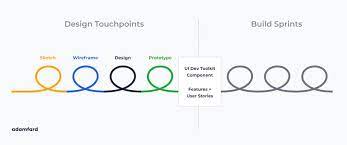The Agile Design Process is a synchronized workflow that effectively integrates design (discovery) and development (delivery).
By incorporating agile techniques into product design, teams can deliver high-quality products in shorter timeframes. This allows them to keep pace with market changes and remain responsive to users’ needs.
Iteration
Iteration is a cycle of repeated steps that are used to improve or refine a product, process, idea or initiative. In computer programming, iterations can be a loop that repeats code until a certain condition is met.
In product design, iteration can be a process where designers produce a draft or sample of what they think will meet the needs of the users, and then revisit it multiple times. This process can be a great way to fine-tune the project until it achieves the desired goals of the client.
The iterative approach also allows teams to make decisions quickly and logically. This can reduce risk and allow teams to make changes and adjustments that might not have been possible in a traditional project methodology like Waterfall.
Iteration is also a great way to test out new features and strategies before investing more time into them. This is especially true in engineering where teams often use iterative processes to implement bug fixes and A/B test new strategies.
Backlog
The backlog is an organized list of tasks that need to be completed to complete a project. It is an integral part of Agile projects and helps to ensure that all necessary tasks are identified and tracked.
Product managers need to focus on a high-level strategic plan that solves problems for their target market, such as conducting market research, data analysis on user experience and interaction, and communicating with sales and marketing teams. This plan then transforms into a product roadmap.
After the roadmap has been mapped out, product teams can create a backlog of tasks. These backlog items can range from near-term projects to longer-term projects.
When creating a backlog, it is important to prioritize high-priority items first so that they are developed as quickly as possible. Longer-term items can be a little more fuzzy, so it is a good idea to get a rough estimate from the development team before deciding on how to prioritize them.
Sprints
A sprint is a short period of time in which the development team works on a specific set of tasks. The purpose of a sprint is to complete the highest-priority user stories in the product backlog while keeping the overall project progress on track.
During the sprint planning process, the team decides which user stories it will work on and how much time they can devote to them. This process is facilitated by the product owner and scrum master.
After a sprint is completed, the team presents its work to the product owner for approval. The product owner then uses the criteria set out in the sprint planning meeting to either accept or reject the work.
Another advantage of a design sprint is that it gives the engineering team the opportunity to try out new ideas without the constraints of existing solutions. This allows a more nimble approach to problem validation.
Planning
Planning is the process of setting goals and objectives for an organization. It also serves as a basis for determining what methods to use in order to accomplish those goals.
Ideally, a plan should be participative and include everyone who is likely to contribute to its success. This ensures that everyone understands the plans and is committed to achieving them.
Another important part of planning is assessing progress and achievements. This can help to identify areas where improvement is needed.
A good way to do this is to involve all team members in the planning process, even those who aren’t designers. This allows them to see how design thinking relates to their roles and how they can contribute to the process.
Teams can start using Agile methodologies at all levels of the organization by inviting product designers to participate in the planning from the beginning of a project. This shows executives and other leaders that design and development are high priorities. They can also minimize unplanned requests, which can influence the schedule of work sprints.





